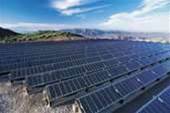
"Someday homeowners will be able to print sheets of these solar cells with inexpensive home-based inkjet printers," he said. "Consumers can then slap the finished product on a wall, roof or billboard to create their own power stations."
Harvesting energy directly from abundant solar radiation using solar cells is emerging as a major component of future global energy strategies, but effectively harnessing renewable energy still has many challenges.
Expensive large-scale infrastructures such as windmills or dams are necessary to drive renewable energy sources, such as wind or hydroelectric power plants.
Purified silicon, also used for making computer chips, is a core material for fabricating conventional solar cells. However, the processing of a material such as purified silicon is complex.
"Developing organic solar cells from polymers, however, is a cheap and potentially simpler alternative," said Mitra.
"We foresee a great deal of interest in our work because solar cells can be inexpensively printed or simply painted on exterior building walls and/or roof tops.
"Imagine driving in your hybrid car with a solar panel painted on the roof, which is producing electricity to drive the engine. The opportunities are endless."
The solar cell developed at NJIT uses carbon nanotubes 50,000 times smaller than a human hair.
Just one nanotube can conduct current better than any conventional electrical wire, and nanotubes are significantly better conductors than copper.
Mitra and his research team took the carbon nanotubes and combined them with tiny carbon buckyballs (known as fullerenes) to form snake-like structures.
Buckyballs trap electrons, although they cannot make electrons flow. Add sunlight to excite the polymers, and the buckyballs will grab the electrons. Nanotubes, behaving like copper wires, will then be able to make the electrons or current flow.
"Using this unique combination in an organic solar cell recipe can enhance the efficiency of future painted-on solar cells. Someday, I hope to see this process become an inexpensive energy alternative for households around the world," concluded Mitra.

.png&h=140&w=231&c=1&s=0)







 iTnews Executive Retreat - Security Leaders Edition
iTnews Executive Retreat - Security Leaders Edition












_(1).jpg&h=140&w=231&c=1&s=0)



